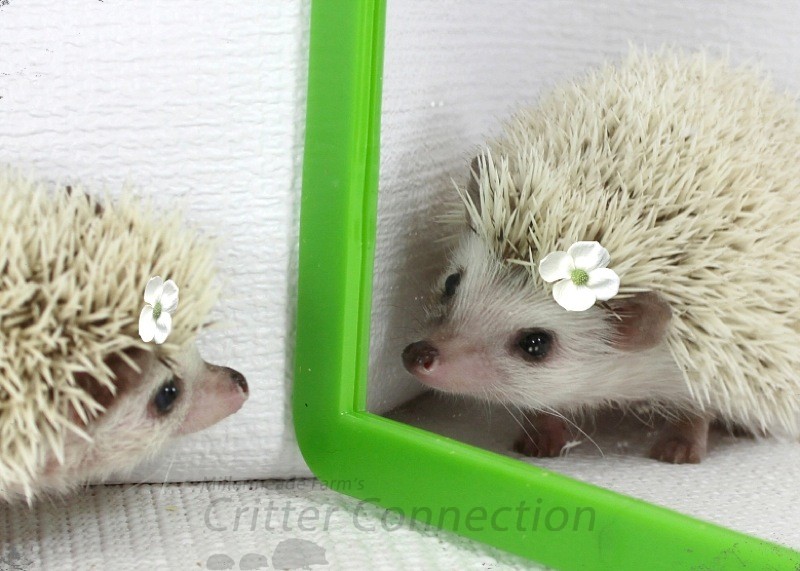Last Updated on August 23, 2022.
In the Wild
- Hedgehogs are normally solitary in the wild, socializing for breeding purposes.
- Males do not help raise the babies, and babies leave the mother shortly after the weaning process.
- Hedgehogs search and scavenge for their own food, and do not depend on other hedgehogs for survival.
Solitary
- There are many books and hedgehog references that identify hedgehogs as solitary creatures that should be housed individually.
- Unlike sugar gliders, prairie dogs and meerkats, hedgehogs do not live in colony settings.
- Hedgehogs do not pair for life, and do not form natural bonds with other hedgehogs in the wild.
- Housing hedgehogs individually is the safest means of housing, and is in no way detrimental to the average pet.
Weanling Babies
- Young hedgehogs often prefer to sleep together, and do better after the weaning process if they are kept in small groups, rather than housed individually.
- By the age of eight weeks, weanling babies should be housed separately by gender.
VIDEO.: Hedgehog baby hog pile
Cohabitation Success
- We have seen many cases of cohabitation success, and many rescue organizations frequently cohabitate compatible hedgehogs.
- Some hedgehogs actively strive to be with other hedgehogs. We have had females which appeared to be happier when they were either breeding or with babies. When the hedgehogs were left alone, they spent a considerable amount of energy trying to escape to join another hedgehog.
Cohabitation Risks
- One disadvantage to cohabitation is that you cannot be sure of the food intake or fecal output of either animal.
- Carefully watching for obesity in one animal or unusual thinness in another may help to alert the owner if there are any problems developing. Routine weighing may also help identify problems that may not be otherwise caught right away.
Female Cohabitation
- Many hedgehog breeders and owners have found that female hedgehogs bred in captivity may prefer, and even crave, companionship and will go to great lengths to be with another hedgehog.
- Females that are raised together have shown some bonding tendencies, but it is not absolutely necessary to purchase multiples for companionship.
- Raising females together can be a positive experience for both hedgehogs, but one must also be prepared to separate them if there are signs of squabbling or any other trouble. So you should have the means to have separate cages if the need would arise.
- Offering each hedgehog their own hideout/igloo and wheel in their shared habitat may help avoid any bickering.
Male Cohabitation
- It is best not to house male hedgehogs together, because they may start fighting at the onset of sexual maturity.
- Hedgehog fights can be quite loud, or their quarreling could go unnoticed until one is injured.
- Some males may perform courtship routines and mount another male.
Fighting and Dominance
- Some huffing and puffing is completely normal between hedgehogs, as their noise is one of their main forms of communication. Squealing, however, can be a sign of aggression and should be closely monitored.
- Occasionally, fights can break out and injuries can result from serious squabbling. The most common types of injury are torn ears, bites on the legs, and bites along the quill skirt.
- We have observed that fighting is most likely to occur between adult hedgehogs or young adult hedgehogs that have not always been cage mates.
- Weanling hedgehogs typically cohabit fine, as long as the same groups are maintained.
- Based on the best chances of cohabitation success, females have the least risk of fighting. However one hedgehog is likely to dominate the other hedgehog, and dominance may become an issue with food. If one hedgehog is “hogging” the food, the two hedgehogs may need to be fed separately.
Chances of Cohabitation Success
- The following percentages of successful companionship are based solely on our 20 plus years of hedgehog-owning experience, as well as our experience in breeding and owning other types of animals.
- These percentages are our own personal beliefs, and if we were betting on cohabitation success, this would be how we would place our bets.
- Two females raised together – 95% chance of success
- Two males raised together not in the presence of females – 85% chance of success
- Two females introduced later in life – 75% chance of success
- Two males introduced later in life – 25% chance of success
VIDEO.: COHABITATION
*Please keep in mind that, to our knowledge, there have been no scientific studies done on successful cohabitation of hedgehogs. The above listed chances of cohabitation success are our own educated guesses. Other breeders are likely to have their own educated guesses that may be different from our own.
Contributors: Gail Smith, MaryLynn McDermott, Melissa Ramos, Coley Emde









